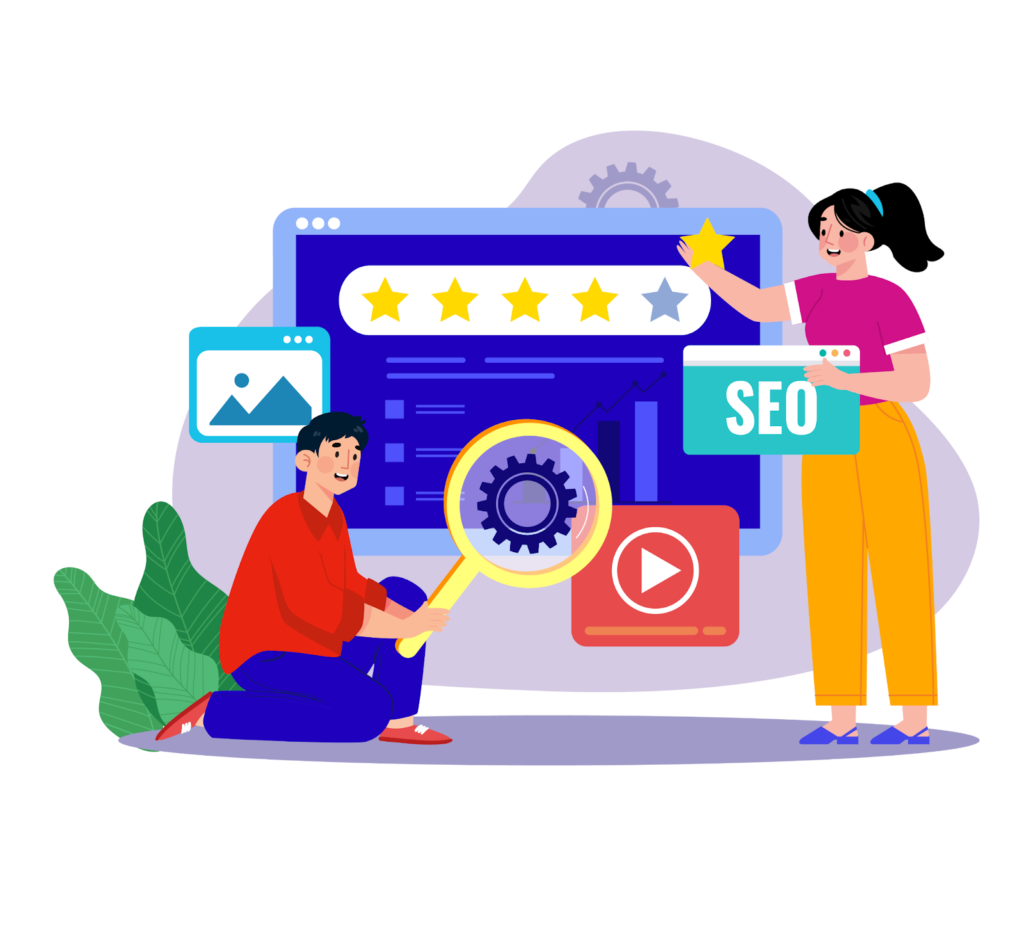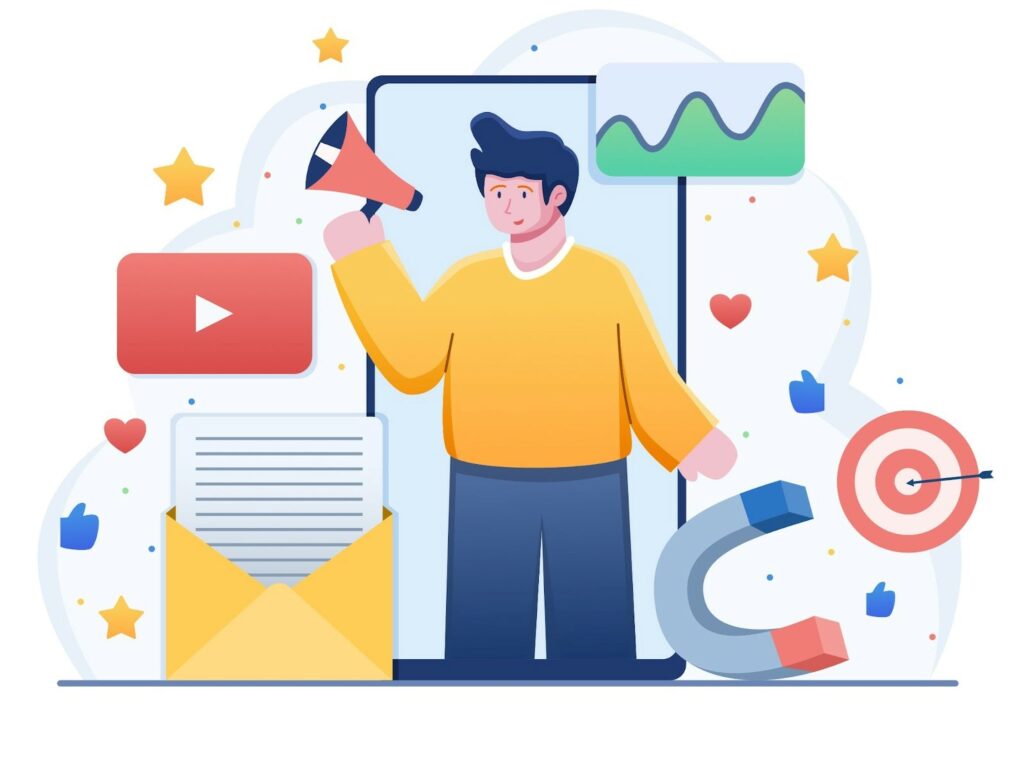If you’re a business owner who wants to grow your business, it’s likely you don’t know where to start. But because there are so many different methods available that can help you increase your visibility to potential prospects, it’s hard to know where to start. That being said, the purpose of this guide is to give you a better understanding of growth marketing tactics, one of the most effective marketing methods that marketers are using in the digital world today, and teach you everything you need to know to grow your business online successfully.
If you put what you learn in this article to good use, this guide can make a night and day difference for your business in a very short amount of time, so stick around!
Now let’s get started!

Growth Marketing
As consumer interests change, marketing is tailored to meet the needs, wants, and tastes of consumers. Also called marketing 2.0, growth marketing takes content marketing, email marketing, SEO optimization, and other marketing techniques, adds technical analysis of every aspect of the consumer journey, and then analyzes their data as a company grows to find what’s working the best.
Growing marketing focuses on guiding your audience through every stage of the marketing funnel, ultimately creating brand ambassadors. Unlike traditional marketing, where leads are converted into customers quickly, growth marketing focuses on building relationships with customers over time. In other words, traditional marketing focuses on acquisition, while growth marketing focuses on retention.
In a nutshell, growth marketing focuses on a wide range of marketing techniques, with data-driven, knowledge-backed experimentation. Then, strategies are molded over time around results to achieve the best possible results at every turn. The goal—is to find the most efficient way to cultivate sustainable success for the company.
Want a FREE Expert Opinion on the Best Way to Grow Your Business? Get a call back from one of our growth marketing specialists!

Team:
A growth marketing team structure should consist of people with different skill sets who work effectively and cohesively to perform all functions within your marketing strategy. Some are specialists in technical fields like SEO or paid advertising, and some are copywriters, account managers, etc.
Ideally, your team should have adaptability and creativity, be great problem solvers, possess leadership skills, and have all the skills necessary to handle all of your marketing processes effectively.

Mindset:
The objective of a growth mindset is to grow your company by focusing on short- and long-term goals and results and then adjusting your strategy according to what gets you the most traction. Those with a growth mindset believe intelligence, abilities, and talents can be learned and improved. A fixed mindset, however, believes that those same traits are inherently stable and unchangeable.
Here’s an example:
Let’s say that you’re a freelancer. You always get clients, but you know nothing about running a business. You think, “Well, I don’t know the first thing about running a business. Maybe I should stay out of it….” This is called a fixed mindset. Someone with a growth mindset would either learn the skills they needed to run their business, try it anyway, or hire someone to do the job. These are the people you see with million-dollar agencies who write books about how to do it.

Technology:
As technology trends evolve, the technology available to us is something you don’t want to ever turn a blind eye to as a marketer. Not just automation and mobile-first marketing. Everyone already knows about that. We’re talking about wearable martech integrations, AI chatbots, data management and customer data platforms, and custom BI software that collects your business data and allows you to see everything about your team’s and your customer’s activity, and make informed business decisions that eliminate bottlenecks and peak sales. Growth marketers won’t hesitate if they see a chance to gain an advantage through software, SEO, paid ads, or custom-embedded solutions that improve user experience. It’s all about getting the results you want.

Tools:
You need tools to grow your business. Whether it’s keyword research, competitive research, finding and managing backlinks, or tracking and managing organic rankings, you will need tools to grow. Some of the best tools for SEO, keyword research, and competitive research are SEMrush and ahrefs. Ask around. This is pretty unanimous.
For automation, there’s HubSpot, Marketo, ExactTarget, and many other options; you’ll have to experiment and see what you like the best. Ahrefs and SEMrush both come with a full suite of tools that include everything you need to grow your business competitively and gain an advantage. The main difference is that SEMrush has content optimization tools, and ahrefs does not. If you don’t know what content optimization is yet, just hold tight. We will discuss that in just a minute.

Process:
Okay, now we’ve discussed growth marketing, how it works, and how it evolves into a fine-tuned marketing machine in every facet. We’ve discussed the growth mindset, the technology, and the tools that growth marketers use to monitor, grow, and automate their processes, but we said we would give you everything you need to grow your business online. So now we’ll discuss the various processes used in growth marketing to help you better understand how to grow your business with different methods.
So, without further ado… Here are some winning growth marketing tactics to skyrocket your business growth:
Identify and Outline Your Goals

It’s super important to set the right goals. Setting measurable and specific short-term and long-term goals will help to guide your team to success and understand how your strategy affects your business. Your goals should align with your company’s overall objectives. Having a clear plan lets marketing teams know their objectives, see how to achieve those objectives, and measure success along the way.
Setting goals helps you to put your marketing goals into perspective. It will also help you to gauge how your marketing efforts are performing against your goals, help you to identify areas that need improvement, and give you a clearer insight into your entire marketing strategy.
Understand Your Target Audience

Understanding your target audience is a crucial step in marketing. It is important to know your target audience so that you can attract and nurture leads and convince them to buy. To identify your target audience, you should build buyer personas for each of your ideal prospect types. Building buyer personas will allow you to understand better what your prospects feel, think, and want at every stage of the buyer journey.
A buyer persona is a profile that you make for your ideal prospects that will allow you to get a clear understanding of their demographics, their wants, their needs, and their pain points, so that you can create blogs, service pages, and other media types that connect with them and help them solve problems, get past obstacles that may be in their way, achieve goals, etc. To learn more about creating buyer personas, read step 2 of this post.
SEO Strategy – One of the Winnable Organic Growth Marketing Tactics

If you’ve never heard of SEO before, in the simplest terms, SEO refers to the process of optimizing your content and performance, and your backlinks coming to your site from other sites so that search engines can find you and so that the people searching get what they are looking for when they enter a search term to search for an answer. There are 3 different areas of SEO optimization to look at; on-page SEO, off-page SEO, and technical SEO.
- On-page SEO: On-page SEO focuses on targeting keywords, content quality, placing alt tags on images, using keywords in your URLs and subheadings, using internal links to link to other pages on your site and external links to authority sources, formatting, and overall user experience.
- Off-page SEO: Off-page SEO mainly focuses on backlinks from other sites to your site.
- Technical SEO: Technical SEO focuses on site performance, page speed, 404 errors, redirects, internal hierarchy, etc.
On-page SEO needs to be at the core of any content marketing strategy. Even though on-page SEO is pretty easy to learn, a lot of people use that use WordPress as their CMS download the Yoast plug-in when they are just learning on-page SEO because it’s very easy to work with, and it makes the job a lot easier on you.
The off-page SEO part takes a little bit of time to get used to, but, for the most part, you want to have well-established relevant sites linking back to your site. Every website that links back to your site is like that website saying, “I like this site and think that they’re a good site,” to search engine algorithms; sort of like a vote of confidence.
However, while backlinks have a lot to do with search engine rankings, you don’t want to buy a lot of backlinks at once from people to try to manipulate your rankings because you can get a penalty for that. So, be careful with them and try to make them look natural if you buy links.
You can also acquire links by publishing valuable content that goes to the top of search engine results pages, which will get natural backlinks with so many people seeing them. You can also guest blog on relevant sites and do an even exchange by manual reach out to get backlinks.
Content Marketing Strategy

After you pick the keywords you want to target, your content marketing strategy should be systematic and deliberate. There are a couple of things you want to take into account when laying out your strategy. You want to find keywords that match the same basic format for your service or product pages. This is because your pages are easier to find and remember when all of your service page urls are in the same format, and it doesn’t look sloppy.
For example, say you want to target the keyword “roofing contractors in Cincinnati, Ohio.” So, if you want to target other cities after that, you would want to make sure they were in the same format. For example, “roofing contractors in Florence, Ohio” as opposed to, “Florence, Ohio roofing contractors,” for example.
Another thing that you want to keep in mind is your blogging strategy. You don’t want to target very high-traffic keywords at the beginning, because you won’t have a great user experience for people with only a couple blogs up. For example, you wouldn’t want to target a keyword with 15,000 monthly searches in your strategy too early in the game, because if you end up on the first page of search engine results, that would put around 5,000+ people on your site, and with one or two blogs for them to read it might be embarrassing.
Aside from that, as long as you create content focused on people searching for search terms and you’re optimizing your copy for SEO, you’re going to rank for a lot of keywords naturally. Generally, your pages will rank for anywhere between 30 and 400 keywords per page aside from the keywords you target.
Choose the Right Keywords

Using the tools we discussed in the “Tools” section above, find keywords that you want use to target and attract prospects to your site. Ahrefs is great for that. So is SEMrush’s keyword magic tool. There are many tools out there for keyword research, though the two mentioned in this post are a favorite of many marketers.
The idea is to find all of the keywords that people search for in search engines when they look for your products or services and then pick the ones with the lowest competition (0-30 competition range) to use for your service pages and blogs. The competition metric on both ahrefs and SEMrush is labeled “KD,” which stands for “keyword difficulty.”
After you’ve done your keyword research and picked the perfect keywords to target, it’s time to make a content calendar to start planning your content marketing strategy. Content marketing when used in conjunction with SEO is one of the most powerful and affordable marketing methods in digital marketing. SEO content brings with it a 14.6% conversion rate and sets you up for long-term growth by using valuable, targeted content to build relationships with your prospects.
Make a Content Calendar

One of the most important tools in your marketing toolkit is your content calendar. You can organize your efforts visually with a content calendar while keeping track of your campaign schedules and editorial plans. Whether you publish one time a week or one time a month, you can use blog posts, expert articles and white papers, press releases, seasonal or holiday greetings, videos or pictures from events, campaigns, and projects, stakeholder stories, case studies; you name it…
There are a multitude of different content types out there you can use to generate traffic, just go with whatever format works for you. Again, as long as your content is made to connect with search engine users, you can’t go wrong. The search engines will automatically love you, and your pages will automatically rank high in search results.
Set Up Analytics to Track KPIs

You’ll need to set up tracking on your website for Google Analytics and Google Search Console. If you want to go the extra mile and get a ton of extra visibility in the long run, you can set up Bing Webmasters and Yandex Webmasters as well.
Using these three analytics tools, not only will your website show up in all major search engines, but your KPIs will be measured and separated into useful metrics, which are then displayed in charts and dashboards in an easy-to-understand manner.
In short, tracking your KPIs allows you to use your marketing budget more efficiently, choose the right channels to reach your target audience, and improve your return on investment over time.
Some of your main key performance indicators are:
- Sessions and Users
- Top Search Queries
- Top Landing Pages
- Users by Gender
- Pages per Session
- Bounce Rate
- New and Returning Visitors
- Time on Page
- Goal Conversion Rate
- Average Page Load Time
- Organic vs Paid Sessions
- Average Session Duration
Creating Valuable Content

After you’ve picked your keywords and made a plan for publishing your content, it’s time to start building valuable content to attract your target audience. Content marketing aims to attract and nurture leads for your business, so your content should be consumer-focused. High-quality, valuable content that is engaging, helpful, thoughtful, and entertaining brings people back to your site for more.
Blogs, how-to articles, infographics, and e-books are just some examples of the type of content that millions of people love to read online. Just remember to start slow and stick with it.
Optimizing Your Content

Optimizing your content for search engines to find it is the most important part of your SEO and content marketing strategy because, without it, it’s like trying to run a car with no gas. Your pages will sit there… Number one hundred and something in search results, and the only people who see your pages will be the ones you share a link with. Again, your on-page optimization should focus on user experience and consist of using your target keywords in your URL, your headings, your alt tags, and having authoritative links proving any statistics or benefits in your content in both the problem and the solution sections of your content. Again, you can use the Yoast SEO plug-in for WordPress if you’re just starting out to help you and you get the hang of it.
Below is a list of all of the on-page SEO factors. If you don’t use WordPress, or you’re not going to use the Yoast plugin, write down or copy these on-page SEO factors and use them as a checklist or guide when you curate your content.
On-Page SEO Factors:
- Keywords
- Readability
- Keywords in Subheadings
- Use of Bulleted Lists
- Use of White Space
- Visual Assets
- Title Tags & Meta Description
- Image Optimization
- Geotagging (if targeting local search)
- Site Speed
- Responsive Design
- URL Structure
- Internal links & Outbound Links
Building Your Subscriber List

Once you have your target audience on your site, it’s time to start getting them to subscribe to your newsletters. Email marketing is one of the most effective marketing methods, paying back an average of $42 for every $1 invested. That’s 4200% ROI! A list of interested customers and prospects is one of the most valuable things a business can have. You can get people to sign up by creating popups and landing pages, offering free e-books, asking customers to sign up when they make a purchase, offering exclusive offers and deals, etc. You can also use quizzes, surveys, exclusive content, free downloads, and other types of media, services, or even products to get people to sign up. After they’ve signed up, then you can start monthly or weekly newsletters, or some brands even send 2-3 emails per week, which from the statistics, seems to get the best results.
Social Media Marketing

Depending on what vertical you sell in, you can take advantage of social media marketing on Facebook, Twitter, LinkedIn, and Instagram and join 93% of other marketers. With more than 2.9 billion people using Facebook alone every month, there’s an audience for every brand on social media. But mastering the targeting, timing, messaging, and platform takes a while.
The platforms you choose to build a following on will depend on what type of product or service you sell. For instance, if you’re a business coach, you would probably build a following on LinkedIn because many people are in business on LinkedIn; it’s more of a business platform. On the other hand, if you owned a bakery, you would likely want to choose Instagram because anything photogenic will get a lot of views on Instagram if you use the right hashtags, you would just have to use local hashtags in your post.
Paid Advertising

With over 5 billion people using the internet today and the numbers increasing by the hundreds of millions each year, paid advertising is one of the best tools you can take advantage of to get immediate visibility for your brand. Whether you advertise on Google, Facebook, Taboola, or one of the other popular platforms or services out there, paid advertisements deliver countless benefits, including; immediate access to the search results pages, instant targeted traffic, and a consistent source of leads, to name a few.
If you’re new at running paid ads, your results can be very rewarding or very disheartening, so it’s best to either learn about how paid ads work first or get someone experienced to run your ad campaign until you get the hang of it. We say this because even though paid advertising uses keywords to target prospects, like SEO, it’s a little different. The difference is that Google and other advertising platforms use special algorithms that judge your ads by their performance. You have to know what you’re doing to get the best ad placements.
A/B Testing

Your ability to attribute value to different tactics will be improved if you consistently measure them against others online. An A/B test’s control, or original test variable, is denoted by test A, while a variation, a new version of test A, is denoted by test B. It involves giving two or more versions of a web page to different segments of website users simultaneously to determine which version has the most impact on business KPIs. A/B testing allows experienced optimizers to make data-driven decisions regarding website optimization with no guesswork.
Conclusion
Hopefully, this information has helped you better understand how to use digital marketing services to grow your online business. If you keep in mind that growth marketing is experimental, constantly measuring, adjusting, and changing with your KPIs and that the goal is to end up with an effective strategy that gets traction at every turn, you’ll be fine. If you found this information useful, it would be great if you could share this information on your favorite social media platform so that other people can find it useful too!
Take care!



